Original URL: https://www.theregister.com/2007/03/01/sapphire_radeon_x1550/
Sapphire Radeon X1550 graphics card
Groovy graphics card and a snip at £45
Posted in Personal Tech, 1st March 2007 15:26 GMT
Review Since it bought ATI last year, AMD has been busy rebranding any number of chipsets and graphics chips in its range. Some of the instances make perfect sense while others are a cynical rebranding of an old chip.
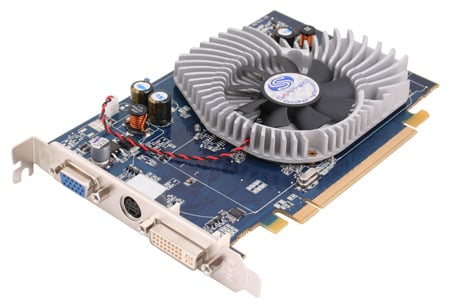
In the case of the Radeon X1050, it’s an X550 under the heatsink, so it’s clear that AMD wants the customer to think that they’re buying a Radeon X1000 series chip when they’re actually getting something rather older and less capable.
Then we come to rebranding that borders on the bizarre, and we hold up as Exhibit A the Radeon X1550, which is neither more nor less than a Radeon X1300. The graphics card that we’re reviewing here is the Sapphire Radeon X1550 but as you’d expect the specification of the card is largely determined by the chip. What we have here is one quad from an X1800 so that’s four pixel shaders and two vertex shaders. It has support for Shader Model 3 and DirectX 9.0c as well as ATi’s hardware Avivo features.
There was talk that the X1550 would move from a 90nm process to 80nm but ATi’s spec states that it uses ‘105, transistors on 90nm fabrication process’ so why, you may wonder, has the chip been renamed? The closest we can get to an answer is that Radeon X1550 has unspecified enhancements that help to optimise it for Windows Vista, in conjunction with BIOS revisions on the graphics card. That message was delivered off the record and we’re none too surprised as it sounds like hogwash, but as we tested the Sapphire with Windows XP SP2 it was all a bit immaterial.
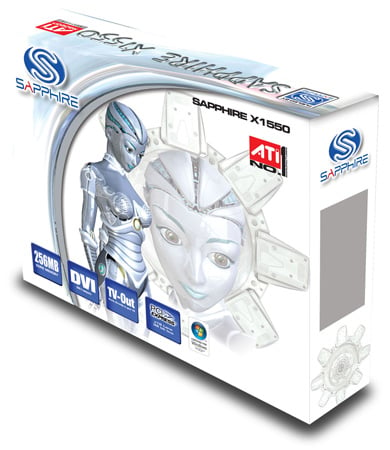
The core runs at 550MHz and uses a 128-bit memory controller to communicate with 256MB of DDR2 memory that operates at an effective speed of 800MHz. We’ve previously tested a Sapphire Radeon X1300XT that used DDR3 memory with a speed of 1375MHz so this X1550 is actually quite conservative, but all is explained when you see the £45 retail price. If we accept that Radeon X1050 has no place inside a current PC, unless you simply want the cheapest possible way to support dual displays, then the X1550 is clearly positioned as the cheapest ‘proper’ ATI graphics card in the market, and it’s £10 cheaper than the GeForce 7300GT.
Before we put them head-to-head let’s take a look at the Sapphire package, which is surprisingly comprehensive. The software consists of PowerDVD 6 (stereo version) and Just Cause, while the bundle of cables is positively generous. There’s a length of s-video cable, a composite-video cable, an s-video to composite adaptor and a splitter cable that supports component-video.
The heatsink is a finned aluminium affair that covers the four memory chips on the face of the card, but it leaves the memory on the back of the card uncovered. It would be unfair to call the fan loud, but it seems to be louder than necessary as it spins rather fast and keeps the X1550 very cool.
We tested the graphics cards on an Asus P5N32-E SLI motherboard with an Intel Core 2 Duo QX6700 processor, 2GB of Corsair memory and a WD740 Raptor hard drive, using Catalyst 7.1 for the ATI cards and Forceware 93.71 for the 7300GT. ATI cards? Yes indeed, because we dug out an Asus EAX1300Pro from the review kit on the shelf, which currently retails for the same £45 as the Sapphire X1550 while, we imagine, stocks last.
The EAX1300Pro was an unpleasant piece of hardware that suffered from terrible artefacts when it was under load. While its test results don’t look too shoddy it is completely beyond the pale when it comes to gaming. The 7300GT had the edge on the X1550 in all of our tests but the difference wasn’t too noticeable on screen. You can use either graphics cards to play intensive games such as Far Cry and FEAR with good quality and at decent resolution, and there is no doubt that both cards fully support Windows Vista Premium.
3DMark06
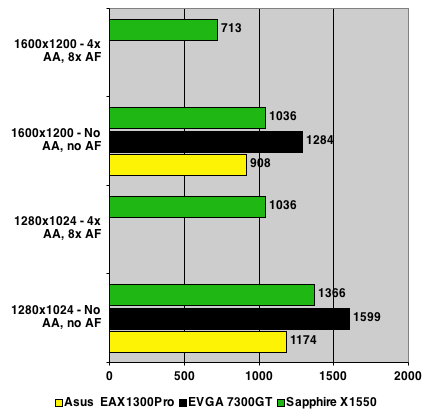
We found that the X1550 could be overclocked from 550/800MHz to 640/920MHz which boosted performance by 15 per cent. At 650/936MHz the image quality deteriorated. The 7300GT could be overclocked to raise performance by ten per cent so the gap is somewhat narrower than it appears however the 7300GT remains the faster of the two chips.
Far Cry
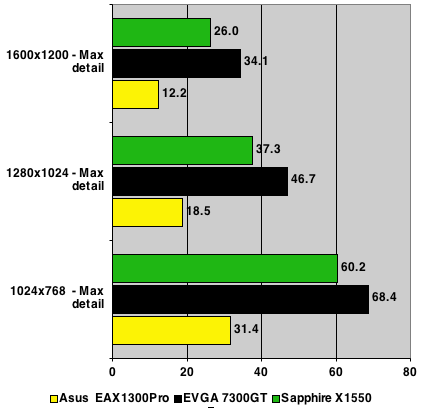
The Sapphire X1300 XT with DDR 3 memory that we mentioned earlier was tested some time ago on a different test PC so we haven’t included the test results. However, one figure jumps off the page: the 3DMark06 score of 2,529. That eclipses either of these DDR 2 cards, so the key point about the X1550 is that it delivers satisfactory performance at an incredibly low price. If you were choosing a graphics card for gaming then it’s a safe bet that you would choose neither of these options, but that misses the point entirely. On this showing the Radeon X1550 is the cheapest proper graphics card that money can buy, and for the time being Sapphire and AMD can consider it’s a job well done.
F.E.A.R.
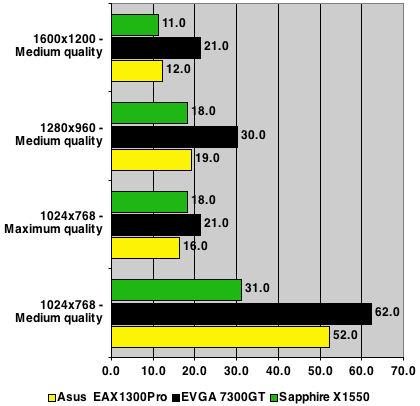
Verdict
Sapphire has done a fine job delivering a DirectX 9.0c graphics card for £45 and the fact of the matter is that the Radeon X1550 is far more relevant to the man in the street than the long-awaited R600 will ever manage.